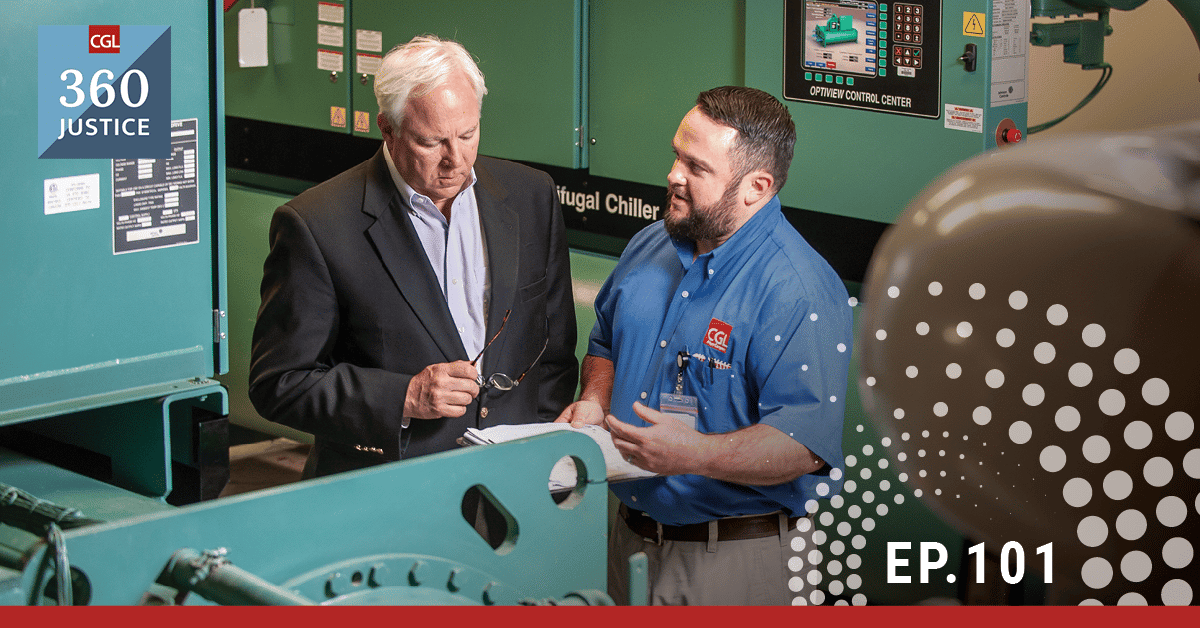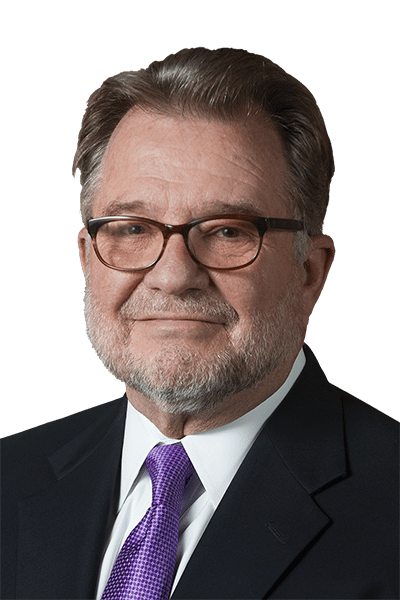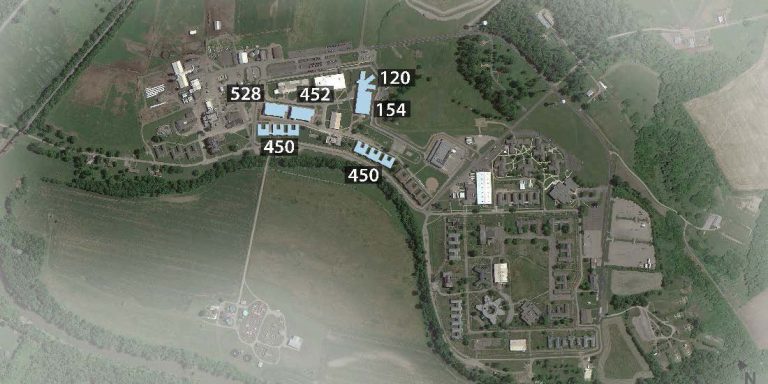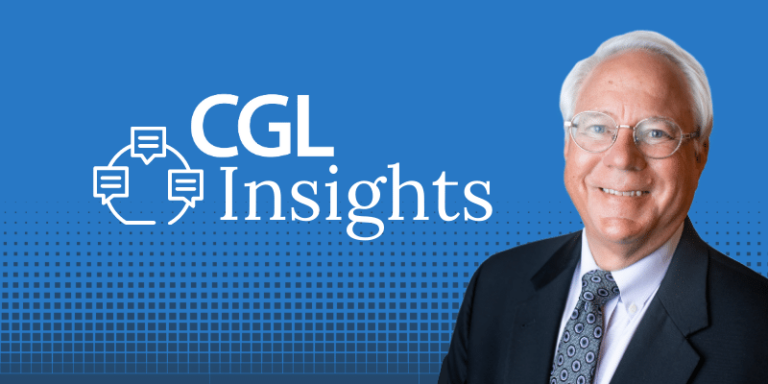
An Introduction to 360 Justice
Hear how the 360 Justice approach has transformed the planning, design, maintenance, and operation of justice facilities across the U.S.
In this debut episode of 360 Justice, Host Eli Gage is joined by colleagues, Joe Lee and Bob Glass, to discuss the state of the criminal justice industry. The trio discusses the benefits of establishing preventive maintenance practices to improve efficiency and increase cost savings through the entire lifecycle of a facility and explores how the industry is evolving to meet the needs of the future. Hear about how CGL’s integrated 360 Justice approach has transformed the planning, design, maintenance, and operation of justice facilities across the U.S.
In this episode, we discuss:
- How 360 Justice is transforming the justice industry
- The current state of criminal justice infrastructure in America
Have questions, comments, or want to talk more about this? Contact the show host, Eli Gage at podcast@cglcompanies.com
Meet Our Guests

Joe Lee, PE
With nearly 40 years of justice experience, Joe Lee, CEO for CGL’s Facility Management division, has a unique understanding of justice facility operations and building system engineering. Joe has completed more than $7 billion worth of public facility construction projects across the U.S. and Puerto Rico. Joe is best known for his system of incorporating maintenance and energy efficiencies into the planning and design of justice facilities, which can be attributed to reducing the overall facility Total Cost of Ownership for public owners.

Bob Glass, AIA
An Architect by trade, Bob Glass, CGL’s Director of Justice Services, is a nationally recognized expert consultant for the planning, conceptualization, and functional analysis of all the criminal justice system sectors. His extensive experience covers work on 500 projects in 38 states and four foreign counties, spanning city, county, state, federal, and international levels; and includes facilities in all degrees of custody for adult men and women, juveniles, and inmates with special needs.
Podcast Transcript
Voice Over:
Welcome to the 360 justice podcast where criminal justice leaders talk about how they are solving tough social infrastructure issues, like aging facilities, insufficient funding, and inadequate staffing, and an ever changing political climate. Here’s your host, Eli gage.
Eli Gage:
Good afternoon, everyone. My name is Eli gage and I wanted to thank you for tuning into our first episode of the three 60 justice podcast. Today. I have two esteemed colleagues on the line, mr. Robert Glass and Joe Lee, both of CGL. And we wanted to talk a little bit today about kind of what’s happened in the past, you know, what’s happening currently and maybe even try to dive into what we think might happen in the future. My guest today, Joe Lee is a, is a Auburn war Eagle with an engineering degree and has been in our market. Now, Joe, how long, how long have you been doing this?
Joe Lee:
Since 1981. 39 years.
Eli Gage:
That was the year I graduated from high school.
Joe Lee:
Thank you. Makes me feel a lot better.
Eli Gage:
And Robert Glass, a, a university of Oregon duck with an architectural degree from the university of Idaho that, um, I know Bob has, you’ve told me several times that you’re now tearing down a lot of the justice facilities that you built, uh, as a kid fresh out of college.
Bob Glass:
There’s been a few, I guess, since 1979. So again, I’m older than Joe, I guess.
Eli Gage:
Guys I wanted to, I wanted to start with, um, interestingly, this month is eight years since we, uh, with the help of the private equity division of hunt, the hunt companies and El Paso went out and bought six different companies in seven months. And did what I think is probably the first and maybe not the last roll up in the criminal justice market. Uh, two of those companies were companies that you each own. Joe, tell me a little bit about what’s changed for you at CGL and, and, uh, how are things different now than they were say eight years ago?
Joe Lee:
Well, I think we, um, have the resources now to do anything in the market than he might could possibly ask us to do from planning early, very, very early planning, operational planning, all the way through facility maintenance and even at least in an owning facilities back to the government. So as a full menu of services that a client can pick from, or that we can deliver all at one time, the main goal is that we deliver the best facilities with the best value to our clients, that they can have a full 50 year design life too. So they get a better building from the very beginning, nothing I worst hearing somebody say, well, it’s been that way since it was built. In our particular case, we can, we can eliminate the errors of the past and eliminate the errors that people have seen from the very beginning.
Eli Gage:
Hey, Bob, going back to you, you sold us your business slightly after the roll up of the primary Carter Global associate Carter globally roll ups in, I think July of 2012, how’s life different for you now?
Bob Glass:
No, as I was thinking back as Joe was talking about that, I think there’s two things. First of all, uh, the planning things of what I’ve always done, but what’s nice now is to be able to do this planning work with all those guys you competed with for 25, 30 years. Cause they’re just like friends to you as you were competing throughout the years. The second thing is, is to have the, the 360 breadth of knowledge now, particularly the maintenance group. Those guys have been vital to us to expand our planning, to facilitate greater success and remove the expand our design through their knowledge of the equipment thing. So I think it’s given me at least a more well rounded experience now.
Joe Lee:
Well, what’s fun is, uh, engaging with a client early on in a project and being able to bring all the, the information solutions that they’re looking for from the very beginning, all the way through the maintenance business, I think took a lot of pride in the fact that we had other capabilities and the planning capability of the site and capabilities, and really, uh, let that shine through through client satisfaction, through bragging about the company to other clients and demonstrating a real desire to make things better for those that we work for.
Eli Gage:
We talked a little bit ago about, um, uh, tease you both about being so old that you’re tearing down the buildings you built 30 years ago, but what do you think that the state of the criminal justice infrastructure in the United States is right now?
Joe Lee:
Well, there’s, uh, around 950 state prisons in the United States of America right now 570 of them were built between 1980 and 2000. And most of those have not been maintained well. So, um, so they’re not in good shape. Um, when we did the work in Alabama, we found that using the facility condition or correctional facility index that we developed that all of them, uh, all their prisons in the state needed replacing. And what that means is, is that it, it would cost more to renovate it and bring it back up to speed than it would be to, um, build new. So every state in 2008 recession went through a down tick on the revenues and maintenance is usually the first thing that gets hit from a funding standpoint when the state loses. And so all the States got hit. So it’s not just Alabama it’s, um, it’s all the States in the union or are suffering from lack of funding and lack of good maintenance on there, on their prisons. And they also don’t really fit the profile. And I’ll let Bob tag on that of the inmates.
Bob Glass:
No, Joe’s right in the, in the eighties, I even hate to say late seventies, I won’t go back that far, but in the early eighties and up through the early nineties County jails and state prisons, all of our facilities, we’ve built these facilities around them, inmate profile at that time, almost looking back on now, too restrictive on that profile, we built probably 60% dorms in many cases in the jails and prisons. And now, as we’re waking up into a new generation of inmates where we’ve left all the lighter custody of out, we, uh, we now need a different kind of prison. They’re not adaptable. We made as a group of justice. Architects made a poor choice of not making adaptable buildings that could change over time. So that’s, that’s our big push forward in this group now is to make sure things we do are adaptable,
Eli Gage:
But wouldn’t you say that in our industry, that’s going to be a ever changing model. I mean, the, the, the beds are different. Now, the people that are in prison, whether it be women aged young people, that’s going to be constant change.
Bob Glass:
It is. I think the one constant, the one change that we’re going to see that probably won’t change back as the pendulum swings. I’m not sure wherever, um, see the reincarceration of those lighter, lighter custody. It makes the low risk felons, the nonviolent people. I don’t think most number come back. So I think, I think what we are doing as a group now is going to move forward into the future of next generations, much better.
Eli Gage:
So, Bob, tell me about some of the stuff, the work that we’ve done. Let’s say since 2012, as we’ve done this roll up, we’ve combined these companies together, we’ve got a different offering, arguably, and we’ve actually been involved in some pretty interesting projects since then. Tell us a little, bit about that.
Bob Glass:
No, I think the staff had gotten out with the capabilities we have and really a good example is when we do planning work now for a jurisdiction that needs a building, we have operational staff sitting in the same room with us. So as we’re planning the spaces, the operational staff, we’re talking about staffing those spaces. So at the end of our planning phase, we know exactly how much staff goes. It’s gonna, it’s gonna take to run that, which allows us to probably end up with Joe really wants to talk about here shortly. I know, but we’re able to talk about total cost of ownership for the first time at the early stages, before we actually design a building, we know how big it is. We know how many staff are going to want it. And Joe’s capabilities in grips. We know what’s going to cost to operate this building for the next 30 years. So the client can make an informed decision before they even start the design building for the first time.
Eli Gage:
Joe Lee, what is total cost of ownership?
Joe Lee:
Total cost of ownership is looking at the whole system of not only the building itself, but delivering the services to the inmates and managing the staff within the building, managing the inmates within the billing. So it involves everything from staffing. As Bob was talking about to, uh, energy and the cost of maintenance, the cost of replacing equipment through the life cycle of the prison. It includes every call center that would go into a typical business software that you would see in a state. When we looked at Alabama as an example, we looked at the staffing model for the existing presence versus a staffing model. If we replace those prisons with newer and better prisons and did some consolidation, but as we looked at that, not only the staffing, but we look at how much it would cost to deliver energy to each one of those present versus the old president.
Joe Lee:
As we looked at the maintenance cost, we looked at every, every call center in order to come up with a solution. And I’ll give you a couple of examples that are in the minute category on a jail we did in Georgia. We made a change while they were pouring the foundations and the slab to add a curb to all the Carters within the building, where there was going to be car traffic to prevent cars that were being driven by inmate and not from hitting the walls, which would calls a paint and patch requirement. When we did the calculation of how much that saved, um, by putting that curb. And while we were pouring all the other, uh, concrete work on that building, and it was somewhere around $200,000 a year. So to think about something that minute and, and how it can save money for 30 years is where we’re Excel.
Joe Lee:
Uh, in the case of Alabama, we were looking at the cost of their energy and, uh, they were spending over $2, a square foot on electrical costs. And we ended up setting a target at a dollar three to come back with a more efficient system to tell you where that dollar three came from. It came from that same facility of that jail that we opened in 2000, almost 20 years ago, and where we did all the calculations to determine what the cost of energy will be for a central energy plant. And we set a target for the engineers and the contractors to hit back then at like a dollar four, I think. And they hit it. And not only do we say money compared to the old jail, but we also saved money with buildings around the jail because we did a master metering job and did actually went into go shed with the power company for the client. So we look at total cost of ownership. It looks at everything, and there was a lot of detail that we have staff that can do the staffing models like Bob was talking about to look at that savings. And we can have guys that specialize in energy, look at that savings. And it goes all the way up and down the call sheet.
Eli Gage:
So Bob, going back to the question of, you know, kind of what’s, what’s transpired since 2012, obviously Alabama’s come up and that’s a sweet spot for us. Cause we, I think we’re uniquely qualified to help that state Hawaii comes to mind. Bob, I believe that the work that we’re doing on the women’s prison is the first public safety project that they’ve done in 20 years
Bob Glass:
Since 1983, I did the last one. So it’s, it’s been longer than 20 years. And, and the other one really that it comes to mind like take a minute, is the Maricopa County intake center. That’s a brand new intake center, a brand new way of doing business. It’s never been, never been done before in larger jurisdictions. Uh, you know, Maricopa County, Phoenix, intakes about 300 inmates a day. It’s a big intake center and they, it’s a whole new way of doing that inside of a building. That’s totally adaptable. They could remodel the whole thing tomorrow. There’s not a single wall. That’s kind of get in the way. So we’ve given them the adaptable building for the first time. And it’s an arch jurisdiction. It’s going to be very heavily toured. And they’re very proud of the building. And they’ll tell you, they’re very proud of CGL involvement and the operational aspects of it.
Bob Glass:
Cause we had our operations guys there the whole time talking about staffing. It’s been through some interesting times with the County as they prepared to open it and staff it, but it, uh, the staffing numbers, we gave them with the numbers they’re using right now. And they’re very proud of it. It actually became for a while. In fact, it still might become a COVID center and in between getting opened now as an intake center. So it’s, again, it’s an adaptability and they’re looking at it’s a lot of different uses could happen. So that’s, that’s what I’m really kind of excited about. As we’re doing these new things for jurisdictions, we’re helping them for the future or just not helping solve their problem. Now we’re helping them for the next 20 years.
Eli Gage:
When you talk about kind of unique delivery, it reminds me of Wayne County right now, where as, as we all know it was during the coronavirus was, was kind of peaking. It’s a very unique project. I would shout out to Jay Shandor, who in the midst of the coronavirus, got on an airplane and flew, moved back to Wayne County to help on that project. And, uh, that’s a very different delivery model as well. So another project uniquely delivered, I would say is the Travis County courthouse. Uh, I think the technical term would be a progressive design build, correct, Bob.
Bob Glass:
It is, yes. It’s one of the newer models that the design build Institute of America is now pushing us as the model of choice. And we did that with a Gensler, Hensel Phelps and, uh, and Hunt. And I think it’s, it’s truly not very well. We’ve all had, I think, I think everybodies been very proud of that building. It’s coming up nice out of the ground.
Eli Gage:
The speed by which that was delivered was kind of unique in our market right now,
Bob Glass:
very unique for a complicated courthouse building. Yes. If those drawings were delivered to the contractor in just over six months. And so it’s very fast,
Eli Gage:
So let’s fast forward a minute not to get into predicting the future, but we, I think at CGL are uniquely positioned to, to help our clients as they migrate through this obviously new world new work environment in terms of the design where it meets the maintenance. Uh, Joe mentioned to me the idea of mechanical rooms outside of the dorms, uh, outside of the security areas, et cetera, et cetera. So what is CGL been doing to identify those design changes that need to happen upfront in anticipation of something like the Coronavirus in the future?
Bob Glass:
And, you know, it was interesting. And I started hearing some of those issues coming up from our maintenance group, cause not toot our own horn or anything, but over the past, gosh, close to 40 years now to have an outside access to the mechanical room, to me is just the standard thing you should do. And what our maintenance group is running into is a series of buildings where architects didn’t do that. And uh, now the maintenance staff has got to go inside of housing areas during the coven time to maintain their hundred units, which is not the best thing for our staff. So it’s, Joe’s got much more firsthand knowledge of that. I just think it’s a, it’s too bad. An owner, a client doesn’t realize they can get better.
Joe Lee:
Right. You know, I think looking at how, um, groups of inmates and groups of officers are managed in the circulation and, and how they move from one spot to the other coincides with how you move maintenance staff in and out, and try not to get too many people in contact with other people. So it’s a whole new dynamic. We’ve always had a sensitivity towards eliminating mob like behavior by reducing the number of, of big groups in a prison and breaking them into smaller groups. But now we’ve got to pay attention of how we deliver food service to those same inmates and medical services. So they’re not in large groups or in close contact with each other. So it’s going to be a challenge and we’re uniquely qualified to help with that challenge because we have so much knowledge of how these buildings actually.
Eli Gage:
So let me switch gears and kind of the final part of this podcast and what do you see going forward? Uh, where does this market go? Obviously funding is going to be a problem. There’s some cares money that’s trickling into this. The counties think people are wondering, do these projects stop? Do they get funded? The problem is not going away while the tax base is so as a guess, because nobody could obviously has a crystal ball here, but what happens now to the end of the year and what happens this time next year?
Bob Glass:
Good question. Our, our, uh, our work with some of the larger counties now right now, probably I think we’re beginning to understand from jurisdictions and from our statisticians, that projecting inmate population that will return to the pre COVID numbers late this year in December. And that’s, that’s my opinion a little bit, but I think we’ll return back to those numbers. I think the issue is going forward from there. How do we handle the period of time in the next year to 14 months? A lot of jurisdictions are looking at their building projects. They, they had on the books and keeping them on the books because they really feel that it keeps economic stimulus, keeps people employed and going. Some jurisdictions are looking at doing business differently. State of Massachusetts, that courts program was looking at doing, we need to build as big now anymore. Now that they’ve been through this, now that we’ve looked at alternative ways to handle court proceedings, should we take a look at how we do courthouses?
Bob Glass:
And so I, and the nice thing is we’re doing two of those. We’re at the forefront. The state’s saying, can you help us figure out how to do courthouse differently for the future? So I think we’re going to be right at the forefront of looking at a lot of different jails and prisons and intake centers and things. How do you change those for the future? What did that look like in future? I’m not sure anybody has the answer right now, but I think we have the best staff to be able to sit with an owner and client and figure it out
Joe Lee:
Well, tagging onto that. I think it’s, uh, also States and counties are going to start looking at what’s the right number of inmates and type of inmates. They should be incarcerating and not to incarcerate those. They shouldn’t be incarcerating. And what’s the right level of funding for a, the infrastructure. You know, there’s going to be a lot, there was in Europe and Canada. It rude awakening that it’s more expensive not to maintain the infrastructure they have. And when they build new infrastructure is vitally important to get something that is economically feasible and sustainable for them to maintain. So I think it’s going to tick up the kind of quality that, that we want to see across the nation and in other places so that you can still provide the services, but at the, at the lowest number possible.
Bob Glass:
I think what this does is give our operational planners a, your chance to sit with clients and look at the way forward. Now, see, I think we have the best chance of building what the future looks like in Dallas County right now in Dallas, Texas, we’re looking at a way with the County to help them use some of the, the Cares Act money to provide some early planning and changes to the intake center, to their front door of the facility and do it the right way, not just set up a tent partially, but really, really figure out what’s the right thing to do going forward now with this, cause this is not going to go away. So how do we, how do we, how do we have intake two or 300 people in a day and keeps some social distance to make the same work better for us? So we’re helping them in that regard to try to use the federal grant monies. We’re helping them identify other funding. We’re obviously looking at alternative methods of funding as, as in the Alabama model, but also at other jurisdictions are saying other ways you can help us identify those Colorado counties asking us to now come down to a study to help them figure out what are the best ways to fund, what are our options they’ll know. So again, they’re turning to us to ask us,
Eli Gage:
Well, thank you guys. I appreciate your time. We are going to try and do a monthly podcast. And, you know, I think it gives us a unique opportunity to reach out to some of the leaders in this industry and, and hear what’s going on. And hopefully it’s informational. I would invite people that are interested in being on the podcast to email me, cause I’m looking for good help. And, um, you should be able to find us on most of the major podcasting channels. So thanks again guys. And, uh, appreciate you.
Voice Over:
Thanks for listening to the 360 justice podcast to see today’s show notes and relevant resources related to today’s topic or to make suggestions on future topics and guests for our show, visit our podcast page at www.cglcompanies.com.








